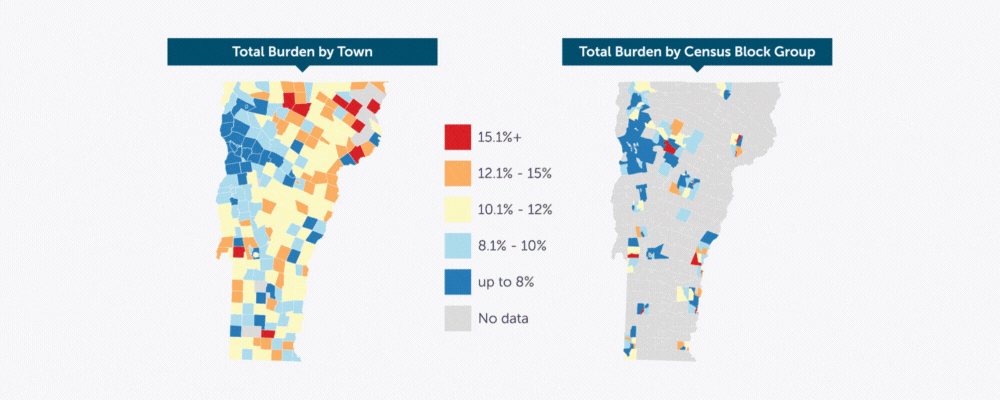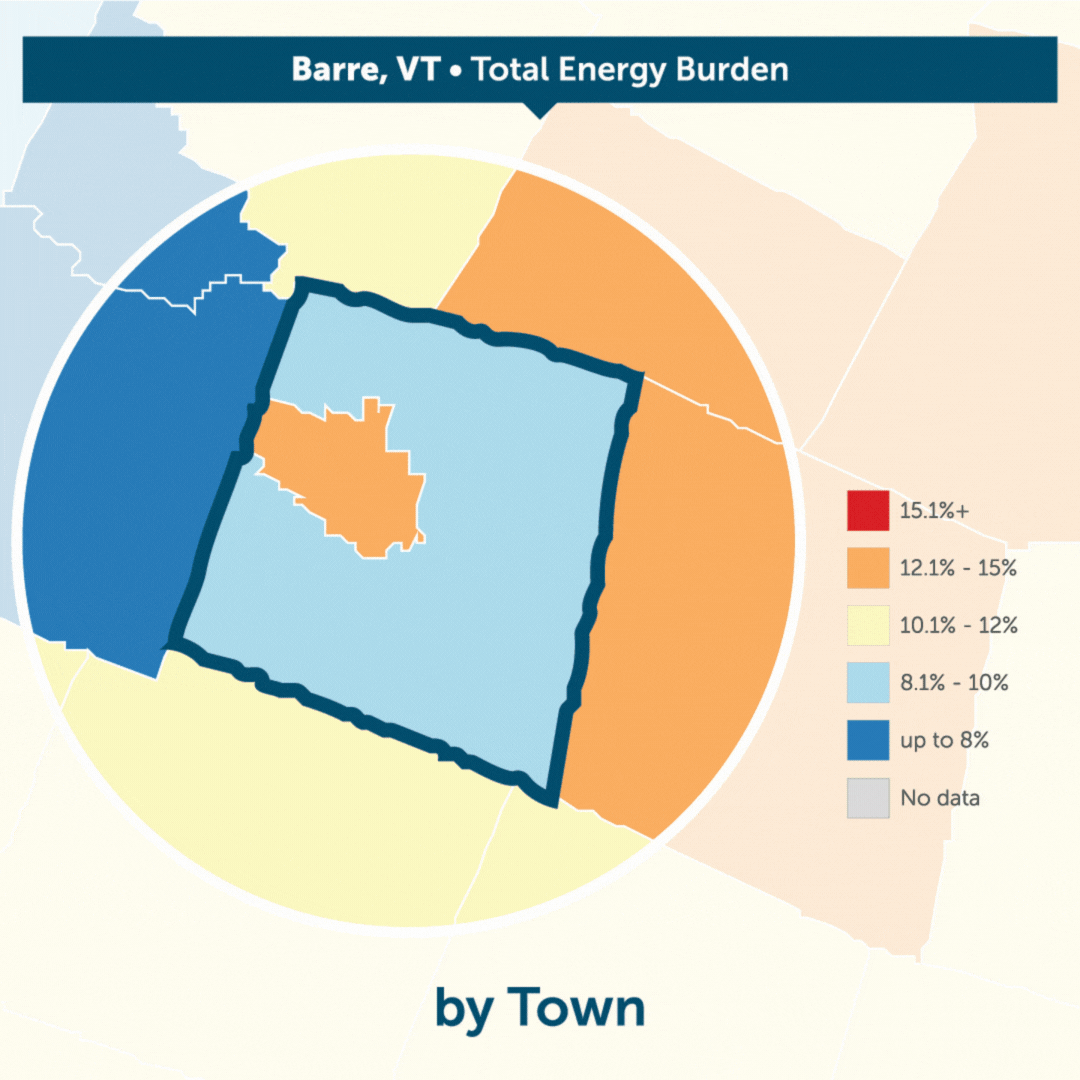What's your energy burden? Understanding the impacts of Vermont's energy costs
Every time you turn on the lights, turn up your thermostat or drive your car, you’re using energy. All that energy comes at a cost. In Vermont, those who spend the most on energy are usually the least able to afford it. As we saw with the recent floods, those who are the hardest hit are least able to weather the storm. As we rebuild, we must be intentional about helping our friends and neighbors become more resilient and save on energy costs.
Efficiency Vermont is releasing our latest Energy Burden Report. It analyzes heating, transportation, and electricity costs in the state, primarily between 2017-2021. And it calculates energy burden as the percentage of household income spent on energy bills.
The results show where in our communities energy costs are greatest, whether we live in a small town in a rural area or an urban neighborhood in a city. For our 2023 report, we also break down energy burden by census block group. That gives deeper insights into the energy burden in our most populated communities.

Vermonters spend, on average, 11 percent of their household income on energy. That’s more than one in every ten dollars spent on heating, driving, and keeping the lights on. We include transportation energy in our calculation because it’s a critical factor for our rural state. Transportation fuels account for almost half (45 percent) of all energy costs in Vermont. Home heating, or thermal energy, accounts for another 35 percent. Electricity costs make up the remaining 20 percent of a household’s energy budget.
If we only count thermal energy and electricity, Vermont’s average energy burden is 5 percent. Using this more narrow calculation, the nonprofit American Council for an Energy-Efficient Economy considers a 6 percent energy burden “high.” Above 10 percent is “severe.” Even when the cost of driving isn’t considered, many Vermont communities still face high energy burdens. Those burdens will only be more acute as families struggle to recover from the recent flooding.
Translating that 11 percent burden to dollars reveals the true costs for households. Vermonters spend more than $7,000 annually on electricity, heating, and transportation. It’s a similar percentage of household income to what we saw in our 2019 report. But rising incomes and rising costs mean an 11 percent energy burden today means Vermonters are spending an additional $1,239 on energy each year compared to 2019.
It’s a reminder that soaring energy costs, especially for most fossil fuels, burden us all. Our New England neighbors know this all too well. Despite comparable energy burdens throughout the northeast, shocking electricity price spikes in Massachusetts, New Hampshire, Rhode Island and Connecticut were common over the last year. That caused household electric costs to jump—in some cases as much as an extra $70 a month. As the only New England state with a regulated electricity market, Vermont’s rates are somewhat insulated from this volatility. But high fossil fuel prices, for generating electricity but especially for household heating, will only add to energy costs and burdens across the region.
A major takeaway from the report is that communities with lower incomes generally face higher energy burdens. Broadly, our report finds residents in the Northeast Kingdom and other rural areas face the greatest energy burdens. That remains true even as our data show these households use typical amounts of energy.
But high energy burdens aren’t confined to Vermont’s rural areas. Census block group data in this report reveals neighborhoods in cities like Rutland, St. Johnsbury, Burlington, and Manchester face among the highest energy burdens in the state. That’s even as neighboring towns or cities have significantly lower burdens. The community with the single highest energy burden in Vermont is in southeast Barre City. Residents of the city’s southwest, downtown, and North End neighborhoods also bear high energy burdens. Analyzing this data by census block group reveals significant differences in household income within a given town or city. These differences stay hidden if we only consider the town-level data.

The destruction from the July floods flowed through familiar tributaries in our state. Communities with some of the highest energy burdens now face some of the most significant flood damage. They are also most at risk of extreme weather events fueled by climate change. Early flood damage assessments show more than 100 properties in Barre City were damaged or destroyed. Many of these are in the city’s North End and include multi-unit housing properties. Our census block group maps show residents in those neighborhoods are among the most energy-burdened in the city. They now face some of the most devastating damage from the floods. Towns like Johnson, Coventry, Ludlow, and Londonderry are also grappling with expensive recoveries—and existing high energy burdens.
Addressing these disparities is a matter of equity. Rebuilding to address them is now a matter of climate justice. It’s not only an issue of rebuilding homes, businesses, apartments, and manufactured homes right now. We need to rebuild for safety, affordability, and comfort in the coming decades. We can’t allow the floods to reinforce historic inequities. We must rebuild with an eye toward resiliency—both against future floods and for our energy future.
Today, Efficiency Vermont uses energy burden to make energy-saving projects for low- and moderate-income Vermonters more accessible. It informs the work we do with our partners to ease high costs with innovative solutions. Efficiency and clean energy technologies can still benefit many Vermonters. That’s especially true in areas where fossil fuels carry the heaviest burden.
Here’s what Efficiency Vermont and our partners are doing to ease energy burdens across Vermont:
Expanding equity and affordability for energy programs and initiatives. The cheapest way to reduce energy costs—and energy burden—is through efficiency. Weatherizing your home, upgrading your furnace, or driving an electric vehicle can reduce your energy burden. As our report shows, we need to close the gap in efficiency projects in energy-burdened communities. We’ll continue to innovate, alongside our partners and regulators, to find new ways to make energy-saving projects more affordable.
Leveraging information about energy burden to design programs for accessibility. Since our our first report in 2016, Efficiency Vermont and partners across the state have worked to make our programs more accessible. That’s helped income-eligible Vermonters get zero-interest Home Energy Loans, provided options for on-bill financing to spread the cost of weatherization over time, and kicked off pilot projects to help Vermonters switch from fossil fuels to cold climate heat pumps. We’re exploring how to go even further by accounting for energy burden in the design of future programs and flood recovery efforts.
Increasing the adoption of clean energy technologies statewide. Electric vehicles and cold-climate heat pumps are already being deployed across Vermont. But as this report shows, there is still a great need and more work to do.
Engaging Vermonters most affected by climate change with meaningful solutions. The groups most likely to feel the impacts of a changing climate include low- and moderate-income Vermonters, renters, rural Vermonters, and Vermonters who identify as Black, Indigenous, and people of color (BIPOC). These groups traditionally lack upfront capital or may lack authority to make decisions about their homes or businesses. They also may face limited options for housing or have been historically denied access to homeownership. Serving these Vermonters is critical but takes sustained commitment and resources.
Exploring how we can embed diversity, equity, and inclusion performance metrics into our state-funded or legislated efficiency programs. As access to clean energy technologies and services expands, we can reduce the energy burden for more customers. A critical path to achieving this goal is reaching underserved groups and creating more just processes and systems. We hope to work with our regulators to complete projects that not only achieve high energy savings at the lowest possible cost, but also consider the broader benefits efficiency projects can provide for individuals, households, and communities.
Efficiency Vermont aims to help Vermonters save money and use less energy. The 2023 Energy Burden Report shows we have a long way to go to alleviate high costs for many Vermont households. As we rebuild from July’s historic floods, we have to make efficiency projects and energy-saving technologies more accessible, affordable, and equitable. These efforts can also help Vermonters reduce their carbon emissions from heating and transportation. And that will help our state become more resilient to the harsh consequences of a changing climate.